Jilan Xu
Advancing Lung Disease Diagnosis in 3D CT Scans
Jul 01, 2025Abstract:To enable more accurate diagnosis of lung disease in chest CT scans, we propose a straightforward yet effective model. Firstly, we analyze the characteristics of 3D CT scans and remove non-lung regions, which helps the model focus on lesion-related areas and reduces computational cost. We adopt ResNeSt50 as a strong feature extractor, and use a weighted cross-entropy loss to mitigate class imbalance, especially for the underrepresented squamous cell carcinoma category. Our model achieves a Macro F1 Score of 0.80 on the validation set of the Fair Disease Diagnosis Challenge, demonstrating its strong performance in distinguishing between different lung conditions.
Bridging Perspectives: A Survey on Cross-view Collaborative Intelligence with Egocentric-Exocentric Vision
Jun 06, 2025Abstract:Perceiving the world from both egocentric (first-person) and exocentric (third-person) perspectives is fundamental to human cognition, enabling rich and complementary understanding of dynamic environments. In recent years, allowing the machines to leverage the synergistic potential of these dual perspectives has emerged as a compelling research direction in video understanding. In this survey, we provide a comprehensive review of video understanding from both exocentric and egocentric viewpoints. We begin by highlighting the practical applications of integrating egocentric and exocentric techniques, envisioning their potential collaboration across domains. We then identify key research tasks to realize these applications. Next, we systematically organize and review recent advancements into three main research directions: (1) leveraging egocentric data to enhance exocentric understanding, (2) utilizing exocentric data to improve egocentric analysis, and (3) joint learning frameworks that unify both perspectives. For each direction, we analyze a diverse set of tasks and relevant works. Additionally, we discuss benchmark datasets that support research in both perspectives, evaluating their scope, diversity, and applicability. Finally, we discuss limitations in current works and propose promising future research directions. By synthesizing insights from both perspectives, our goal is to inspire advancements in video understanding and artificial intelligence, bringing machines closer to perceiving the world in a human-like manner. A GitHub repo of related works can be found at https://github.com/ayiyayi/Awesome-Egocentric-and-Exocentric-Vision.
AOR: Anatomical Ontology-Guided Reasoning for Medical Large Multimodal Model in Chest X-Ray Interpretation
May 05, 2025Abstract:Chest X-rays (CXRs) are the most frequently performed imaging examinations in clinical settings. Recent advancements in Large Multimodal Models (LMMs) have enabled automated CXR interpretation, enhancing diagnostic accuracy and efficiency. However, despite their strong visual understanding, current Medical LMMs (MLMMs) still face two major challenges: (1) Insufficient region-level understanding and interaction, and (2) Limited accuracy and interpretability due to single-step reasoning. In this paper, we empower MLMMs with anatomy-centric reasoning capabilities to enhance their interactivity and explainability. Specifically, we first propose an Anatomical Ontology-Guided Reasoning (AOR) framework, which centers on cross-modal region-level information to facilitate multi-step reasoning. Next, under the guidance of expert physicians, we develop AOR-Instruction, a large instruction dataset for MLMMs training. Our experiments demonstrate AOR's superior performance in both VQA and report generation tasks.
Learning Streaming Video Representation via Multitask Training
Apr 28, 2025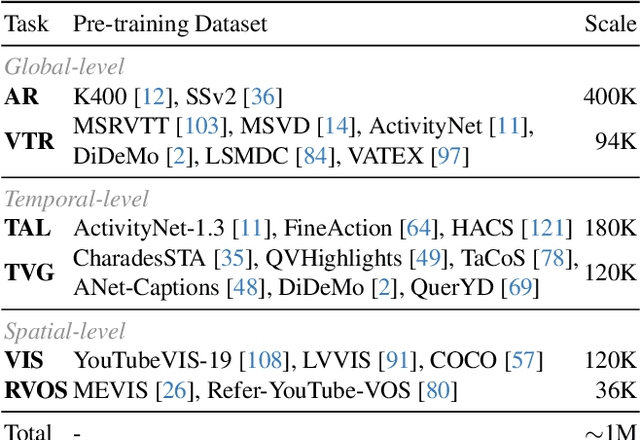

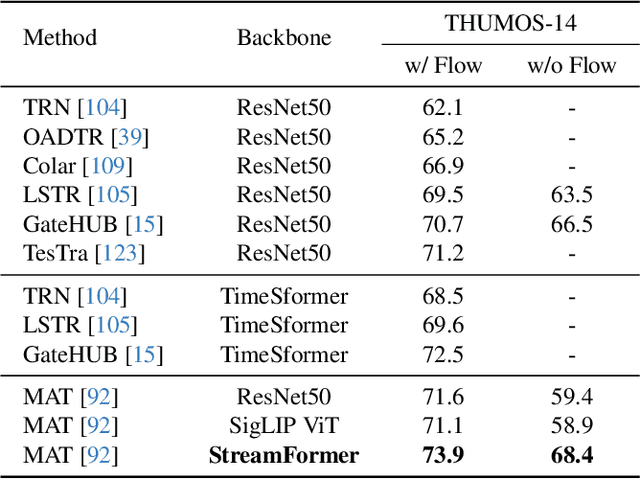
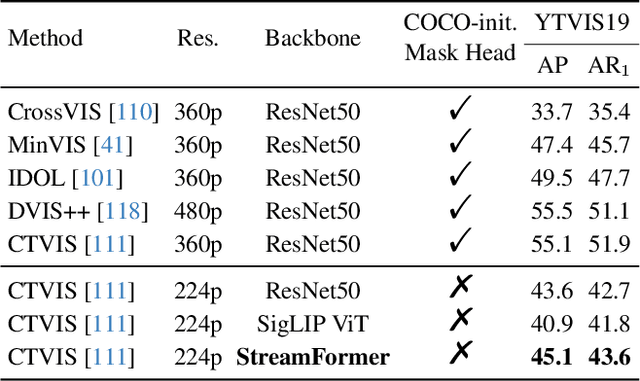
Abstract:Understanding continuous video streams plays a fundamental role in real-time applications including embodied AI and autonomous driving. Unlike offline video understanding, streaming video understanding requires the ability to process video streams frame by frame, preserve historical information, and make low-latency decisions.To address these challenges, our main contributions are three-fold. (i) We develop a novel streaming video backbone, termed as StreamFormer, by incorporating causal temporal attention into a pre-trained vision transformer. This enables efficient streaming video processing while maintaining image representation capability.(ii) To train StreamFormer, we propose to unify diverse spatial-temporal video understanding tasks within a multitask visual-language alignment framework. Hence, StreamFormer learns global semantics, temporal dynamics, and fine-grained spatial relationships simultaneously. (iii) We conduct extensive experiments on online action detection, online video instance segmentation, and video question answering. StreamFormer achieves competitive results while maintaining efficiency, demonstrating its potential for real-time applications.
EgoExo-Gen: Ego-centric Video Prediction by Watching Exo-centric Videos
Apr 16, 2025
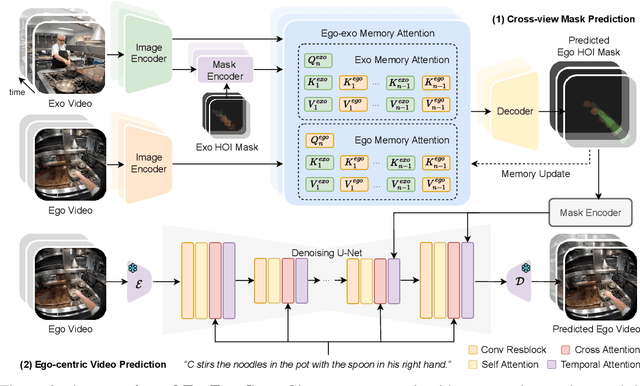

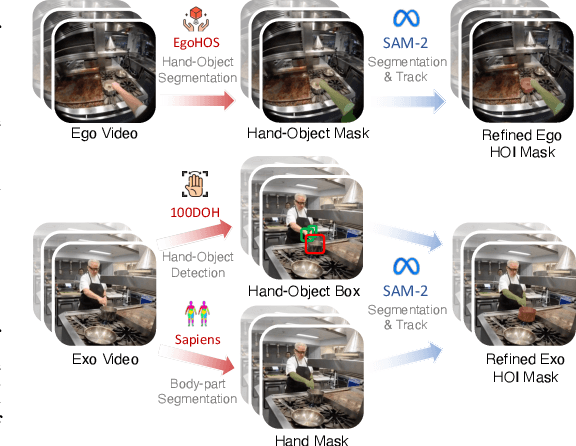
Abstract:Generating videos in the first-person perspective has broad application prospects in the field of augmented reality and embodied intelligence. In this work, we explore the cross-view video prediction task, where given an exo-centric video, the first frame of the corresponding ego-centric video, and textual instructions, the goal is to generate futur frames of the ego-centric video. Inspired by the notion that hand-object interactions (HOI) in ego-centric videos represent the primary intentions and actions of the current actor, we present EgoExo-Gen that explicitly models the hand-object dynamics for cross-view video prediction. EgoExo-Gen consists of two stages. First, we design a cross-view HOI mask prediction model that anticipates the HOI masks in future ego-frames by modeling the spatio-temporal ego-exo correspondence. Next, we employ a video diffusion model to predict future ego-frames using the first ego-frame and textual instructions, while incorporating the HOI masks as structural guidance to enhance prediction quality. To facilitate training, we develop an automated pipeline to generate pseudo HOI masks for both ego- and exo-videos by exploiting vision foundation models. Extensive experiments demonstrate that our proposed EgoExo-Gen achieves better prediction performance compared to previous video prediction models on the Ego-Exo4D and H2O benchmark datasets, with the HOI masks significantly improving the generation of hands and interactive objects in the ego-centric videos.
An Egocentric Vision-Language Model based Portable Real-time Smart Assistant
Mar 06, 2025Abstract:We present Vinci, a vision-language system designed to provide real-time, comprehensive AI assistance on portable devices. At its core, Vinci leverages EgoVideo-VL, a novel model that integrates an egocentric vision foundation model with a large language model (LLM), enabling advanced functionalities such as scene understanding, temporal grounding, video summarization, and future planning. To enhance its utility, Vinci incorporates a memory module for processing long video streams in real time while retaining contextual history, a generation module for producing visual action demonstrations, and a retrieval module that bridges egocentric and third-person perspectives to provide relevant how-to videos for skill acquisition. Unlike existing systems that often depend on specialized hardware, Vinci is hardware-agnostic, supporting deployment across a wide range of devices, including smartphones and wearable cameras. In our experiments, we first demonstrate the superior performance of EgoVideo-VL on multiple public benchmarks, showcasing its vision-language reasoning and contextual understanding capabilities. We then conduct a series of user studies to evaluate the real-world effectiveness of Vinci, highlighting its adaptability and usability in diverse scenarios. We hope Vinci can establish a new framework for portable, real-time egocentric AI systems, empowering users with contextual and actionable insights. Including the frontend, backend, and models, all codes of Vinci are available at https://github.com/OpenGVLab/vinci.
Modeling Fine-Grained Hand-Object Dynamics for Egocentric Video Representation Learning
Mar 02, 2025Abstract:In egocentric video understanding, the motion of hands and objects as well as their interactions play a significant role by nature. However, existing egocentric video representation learning methods mainly focus on aligning video representation with high-level narrations, overlooking the intricate dynamics between hands and objects. In this work, we aim to integrate the modeling of fine-grained hand-object dynamics into the video representation learning process. Since no suitable data is available, we introduce HOD, a novel pipeline employing a hand-object detector and a large language model to generate high-quality narrations with detailed descriptions of hand-object dynamics. To learn these fine-grained dynamics, we propose EgoVideo, a model with a new lightweight motion adapter to capture fine-grained hand-object motion information. Through our co-training strategy, EgoVideo effectively and efficiently leverages the fine-grained hand-object dynamics in the HOD data. Extensive experiments demonstrate that our method achieves state-of-the-art performance across multiple egocentric downstream tasks, including improvements of 6.3% in EK-100 multi-instance retrieval, 5.7% in EK-100 classification, and 16.3% in EGTEA classification in zero-shot settings. Furthermore, our model exhibits robust generalization capabilities in hand-object interaction and robot manipulation tasks. Code and data are available at https://github.com/OpenRobotLab/EgoHOD/.
Vinci: A Real-time Embodied Smart Assistant based on Egocentric Vision-Language Model
Dec 30, 2024



Abstract:We introduce Vinci, a real-time embodied smart assistant built upon an egocentric vision-language model. Designed for deployment on portable devices such as smartphones and wearable cameras, Vinci operates in an "always on" mode, continuously observing the environment to deliver seamless interaction and assistance. Users can wake up the system and engage in natural conversations to ask questions or seek assistance, with responses delivered through audio for hands-free convenience. With its ability to process long video streams in real-time, Vinci can answer user queries about current observations and historical context while also providing task planning based on past interactions. To further enhance usability, Vinci integrates a video generation module that creates step-by-step visual demonstrations for tasks that require detailed guidance. We hope that Vinci can establish a robust framework for portable, real-time egocentric AI systems, empowering users with contextual and actionable insights. We release the complete implementation for the development of the device in conjunction with a demo web platform to test uploaded videos at https://github.com/OpenGVLab/vinci.
CG-Bench: Clue-grounded Question Answering Benchmark for Long Video Understanding
Dec 16, 2024



Abstract:Most existing video understanding benchmarks for multimodal large language models (MLLMs) focus only on short videos. The limited number of benchmarks for long video understanding often rely solely on multiple-choice questions (MCQs). However, because of the inherent limitation of MCQ-based evaluation and the increasing reasoning ability of MLLMs, models can give the current answer purely by combining short video understanding with elimination, without genuinely understanding the video content. To address this gap, we introduce CG-Bench, a novel benchmark designed for clue-grounded question answering in long videos. CG-Bench emphasizes the model's ability to retrieve relevant clues for questions, enhancing evaluation credibility. It features 1,219 manually curated videos categorized by a granular system with 14 primary categories, 171 secondary categories, and 638 tertiary categories, making it the largest benchmark for long video analysis. The benchmark includes 12,129 QA pairs in three major question types: perception, reasoning, and hallucination. Compensating the drawbacks of pure MCQ-based evaluation, we design two novel clue-based evaluation methods: clue-grounded white box and black box evaluations, to assess whether the model generates answers based on the correct understanding of the video. We evaluate multiple closed-source and open-source MLLMs on CG-Bench. Results indicate that current models significantly underperform in understanding long videos compared to short ones, and a significant gap exists between open-source and commercial models. We hope CG-Bench can advance the development of more trustworthy and capable MLLMs for long video understanding. All annotations and video data are released at https://cg-bench.github.io/leaderboard/.
EgoVideo: Exploring Egocentric Foundation Model and Downstream Adaptation
Jun 27, 2024



Abstract:In this report, we present our solutions to the EgoVis Challenges in CVPR 2024, including five tracks in the Ego4D challenge and three tracks in the EPIC-Kitchens challenge. Building upon the video-language two-tower model and leveraging our meticulously organized egocentric video data, we introduce a novel foundation model called EgoVideo. This model is specifically designed to cater to the unique characteristics of egocentric videos and provides strong support for our competition submissions. In the Ego4D challenges, we tackle various tasks including Natural Language Queries, Step Grounding, Moment Queries, Short-term Object Interaction Anticipation, and Long-term Action Anticipation. In addition, we also participate in the EPIC-Kitchens challenge, where we engage in the Action Recognition, Multiple Instance Retrieval, and Domain Adaptation for Action Recognition tracks. By adapting EgoVideo to these diverse tasks, we showcase its versatility and effectiveness in different egocentric video analysis scenarios, demonstrating the powerful representation ability of EgoVideo as an egocentric foundation model. Our codebase and pretrained models are publicly available at https://github.com/OpenGVLab/EgoVideo.
 Add to Chrome
Add to Chrome Add to Firefox
Add to Firefox Add to Edge
Add to Edge